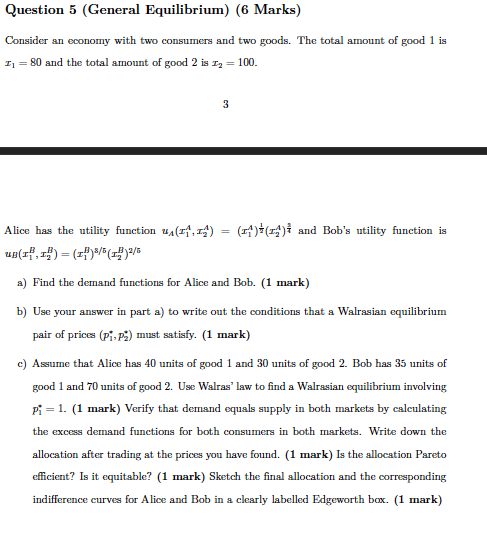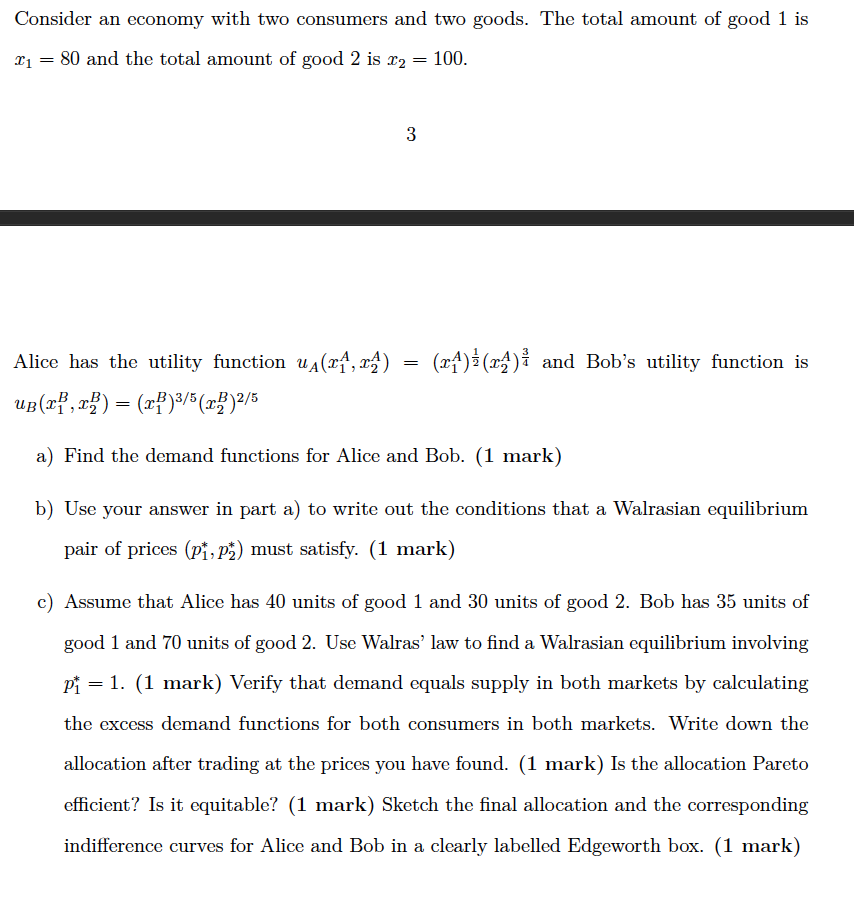
 All the info that is given, please help.
All the info that is given, please help.
Question 5 (General Equilibrium) (6 Marks) Consider an economy with two consumers and two goods. The total amount of good 1 is I1 = 80 and the total amount of good 2 is In = 100. 3 Alice has the utility function (21,1A) = (11)+(A) and Bob's utility function is u(,1)=(x)/(?)% a) Find the demand functions for Alice and Bob. (1 mark) b) Use your answer in part a) to write out the conditions that a Walrasian equilibrium pair of prices (P1-P) must satisfy. (1 mark) c) Assume that Alice has 40 units of good 1 and 30 units of good 2. Bob has 35 units of good 1 and 70 units of good 2. Use Walras' law to find a Walrasian equilibrium involving pi= 1. (1 mark) Verify that demand equals supply in both markets by calculating the excess demand functions for both consumers in both markets. Write down the allocation after trading at the prices you have found. (1 mark) Is the allocation Pareto efficient? Is it equitable? (1 mark) Sketch the final allocation and the corresponding indifference curves for Alice and Bob in a clearly labelled Edgeworth box. (1 mark) Consider an economy with two consumers and two goods. The total amount of good 1 is 21 = 80 and the total amount of good 2 is x2 = 100. 3 Alice has the utility function un(r, TA) = (r^) (mA) and Bob's utility function is Ub(XR, X}) = (x+)3/5(x)2/5 a) Find the demand functions for Alice and Bob. (1 mark) b) Use your answer in part a) to write out the conditions that a Walrasian equilibrium pair of prices (P1,p) must satisfy. (1 mark) c) Assume that Alice has 40 units of good 1 and 30 units of good 2. Bob has 35 units of good 1 and 70 units of good 2. Use Walras' law to find a Walrasian equilibrium involving pi = 1. (1 mark) Verify that demand equals supply in both markets by calculating the excess demand functions for both consumers in both markets. Write down the allocation after trading at the prices you have found. (1 mark) Is the allocation Pareto efficient? Is it equitable? (1 mark) Sketch the final allocation and the corresponding indifference curves for Alice and Bob in a clearly labelled Edgeworth box. (1 mark) Question 5 (General Equilibrium) (6 Marks) Consider an economy with two consumers and two goods. The total amount of good 1 is I1 = 80 and the total amount of good 2 is In = 100. 3 Alice has the utility function (21,1A) = (11)+(A) and Bob's utility function is u(,1)=(x)/(?)% a) Find the demand functions for Alice and Bob. (1 mark) b) Use your answer in part a) to write out the conditions that a Walrasian equilibrium pair of prices (P1-P) must satisfy. (1 mark) c) Assume that Alice has 40 units of good 1 and 30 units of good 2. Bob has 35 units of good 1 and 70 units of good 2. Use Walras' law to find a Walrasian equilibrium involving pi= 1. (1 mark) Verify that demand equals supply in both markets by calculating the excess demand functions for both consumers in both markets. Write down the allocation after trading at the prices you have found. (1 mark) Is the allocation Pareto efficient? Is it equitable? (1 mark) Sketch the final allocation and the corresponding indifference curves for Alice and Bob in a clearly labelled Edgeworth box. (1 mark) Consider an economy with two consumers and two goods. The total amount of good 1 is 21 = 80 and the total amount of good 2 is x2 = 100. 3 Alice has the utility function un(r, TA) = (r^) (mA) and Bob's utility function is Ub(XR, X}) = (x+)3/5(x)2/5 a) Find the demand functions for Alice and Bob. (1 mark) b) Use your answer in part a) to write out the conditions that a Walrasian equilibrium pair of prices (P1,p) must satisfy. (1 mark) c) Assume that Alice has 40 units of good 1 and 30 units of good 2. Bob has 35 units of good 1 and 70 units of good 2. Use Walras' law to find a Walrasian equilibrium involving pi = 1. (1 mark) Verify that demand equals supply in both markets by calculating the excess demand functions for both consumers in both markets. Write down the allocation after trading at the prices you have found. (1 mark) Is the allocation Pareto efficient? Is it equitable? (1 mark) Sketch the final allocation and the corresponding indifference curves for Alice and Bob in a clearly labelled Edgeworth box. (1 mark)

 All the info that is given, please help.
All the info that is given, please help.





